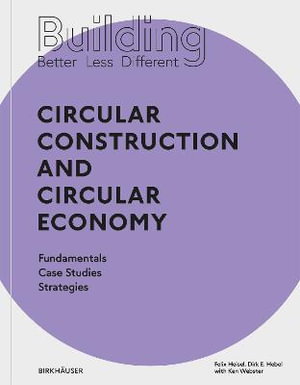| Sun | 10am – 5pm |
| Mon | 9am – 5:30pm |
| Tue | 9am – 5:30pm |
| Wed | 9am – 5:30pm |
| Thu | 9am – 5:30pm |
| Fri | 9am – 7pm |
| Sat | 9am – 5pm |
Ask our staff anything about our shop or products, or share your feedback.

PublishedBirkhauser, November 2022 |
ISBN9783035621099 |
FormatSoftcover, 160 pages |
Dimensions28cm × 22cm |
Wahrend Nachhaltigkeit zur alles ubergreifenden Leitlinie gesellschaftlichen Handels werden soll, sind zugleich ihre Mittel und Wege alles andere als eindeutig klar. Aus ihrem ganzheitlichen Verstandnis heraus muss Nachhaltigkeit technisch-materielle, soziale, oekonomische, oekologische und auch ethische Strategien vereinen, zwischen denen es komplexe Wechselwirkungen und oft genug auch Ziel- und Prioritatskonflikte gibt.
In keinem anderen Bereich lassen sich diese Zusammenhange besser verstehen, darstellen und beeinflussen als im Bauwesen.
"Besser - Weniger - Anders Bauen" greift in jedem Band zwei Bereiche von Nachhaltigkeit auf, deren Wechselwirkungen besonders wichtig und zugleich besonders gut zu erfassen sind. Nach einfuhrenden UEberblicksdarstellungen werden fur jeden Bereich etablierte Methoden, aktuelle Entwicklungen und akute Konfliktfelder beschrieben, analysiert und an internationalen Fallbeispielen im Detail dargestellt. Dies geschieht entlang der Nachhaltigkeitskriterien von Effizienz ("besser" ), Suffizienz ("weniger" ) und Konsistenz ("anders" ).
Der erste Band stellt Konzepte, Methoden und Beispiele fur Kreislaufe im Bauwesen und in der Wirtschaft dar. Urban Mining und kreislaufgerechtes Bauen sind unterschiedliche Umgangsweisen mit den Herausforderungen in Architektur und Stadtebau. Sie werden mit Methoden des Ruckbaus und des sortenreinen Konstruierens betrieben und von Werkzeugen wie Materialpassen und -datenbanken gestutzt. Die Kreislaufwirtschaft erschoepft sich keineswegs im Recycling, sondern umfasst eine weite Spanne von lokalen Gemeinschaftsprojekten uber neue Eigentums- und Unterhaltsmodelle bis hin zu Steuerungsmechanismen wie dem CO2-Preis mit Klimapramie.

